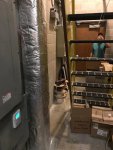malachi constant
Senior Member
- Location
- Minneapolis
We have a project being held up for occupancy due to the building inspector objecting to the location of a 100A breaker panel. The panel is located in an M/E room which contains a tall ship's ladder. Imagine the ladder being about 18"~24" off the wall, you squeeze past it so now you are under it. The panel is located under here, on the same wall you squeezed past, tucked a few feet in from the ladder. There is no obstruction above, and there is adequate (more than code-minimum) working clearance in front of it. The door opens just fine. Etc. The electrical inspector was consulted on this prior to installation and had no problem with it. However it is now installed and the building inspector says there is "not adequate access into the room" and would like us to comment.
I oversimplified one thing about the existing space - after you squeeze past the stairs through that 18"~24" opening there is a vertical duct about 8" deep. Requires a taller person to duck a little as they go past it so their head doesn't hit the bottom side of the stairs. That said there are plenty of folks on site who are large and tall and none have issue squeezing back there.
I have personally had to crawl over/under/through some pretty challenging obstacles in my career to get to a panel. I can understand the desire to make panels more accessible, but this does not strike me as particularly onerous. That said if there is a code issue, be it electrical or building code, then code is code and we'll figure out somewhere else to move it. We are operating under 2014 NEC, all I can find is:
* 110.26 "Access and working space shall be provided and maintained about all electrical equipment to permit ready and safe operation and maintenance of such equipment." Equipment is broadly defined and many pieces of "equipment" are only maintainable in a crawl space or on a ladder.
* 110.26 (C) (1) "At least one entrance of sufficient area shall be provided to give access to and egress from working space about electrical equipment." Great. "Sufficient area." I read that as ""sufficient area to give access to and egress from working space..." which (depending on the exact definition of sufficient area" I would argue we have here.
* 110.26 (D) requires adequate illumination, I doubt there is a light under there. That is probably a necessary change to meet NEC.
If any of you have experience here please let me know. Thanks!
I oversimplified one thing about the existing space - after you squeeze past the stairs through that 18"~24" opening there is a vertical duct about 8" deep. Requires a taller person to duck a little as they go past it so their head doesn't hit the bottom side of the stairs. That said there are plenty of folks on site who are large and tall and none have issue squeezing back there.
I have personally had to crawl over/under/through some pretty challenging obstacles in my career to get to a panel. I can understand the desire to make panels more accessible, but this does not strike me as particularly onerous. That said if there is a code issue, be it electrical or building code, then code is code and we'll figure out somewhere else to move it. We are operating under 2014 NEC, all I can find is:
* 110.26 "Access and working space shall be provided and maintained about all electrical equipment to permit ready and safe operation and maintenance of such equipment." Equipment is broadly defined and many pieces of "equipment" are only maintainable in a crawl space or on a ladder.
* 110.26 (C) (1) "At least one entrance of sufficient area shall be provided to give access to and egress from working space about electrical equipment." Great. "Sufficient area." I read that as ""sufficient area to give access to and egress from working space..." which (depending on the exact definition of sufficient area" I would argue we have here.
* 110.26 (D) requires adequate illumination, I doubt there is a light under there. That is probably a necessary change to meet NEC.
If any of you have experience here please let me know. Thanks!


